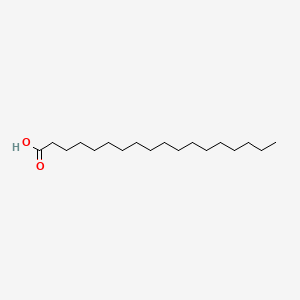| MeSH term | MeSH ID | Detail |
|---|---|---|
| Hemolysis | D006461 | 131 associated lipids |
| Kidney Failure, Chronic | D007676 | 51 associated lipids |
| Diabetes Mellitus | D003920 | 90 associated lipids |
| Otitis Media | D010033 | 12 associated lipids |
| Arrhythmias, Cardiac | D001145 | 42 associated lipids |
| Breast Neoplasms | D001943 | 24 associated lipids |
| Dermatitis, Contact | D003877 | 59 associated lipids |
| Bacterial Infections | D001424 | 21 associated lipids |
| Lung Neoplasms | D008175 | 171 associated lipids |
| Burns | D002056 | 34 associated lipids |
| Insulinoma | D007340 | 28 associated lipids |
| Pancreatic Neoplasms | D010190 | 77 associated lipids |
| Reperfusion Injury | D015427 | 65 associated lipids |
| Liver Neoplasms | D008113 | 8 associated lipids |
| Diabetes Mellitus, Type 1 | D003922 | 56 associated lipids |
| Diabetes Mellitus, Type 2 | D003924 | 87 associated lipids |
| Cattle Diseases | D002418 | 24 associated lipids |
| Fatty Liver | D005234 | 48 associated lipids |
| Mammary Neoplasms, Experimental | D008325 | 67 associated lipids |
| Body Weight | D001835 | 333 associated lipids |
stearic acid
stearic acid is a lipid of Fatty Acyls (FA) class. Stearic acid is associated with abnormalities such as Helminthiasis, Exanthema, Chronic disease, Obesity and Dyslipidemias. The involved functions are known as acyltransferase activity, Mutation, Cell division, cell fate and Fatty Acid Metabolism. Stearic acid often locates in membrane fraction, Mouse Liver, Membrane, Body tissue and Endoplasmic reticulum, membrane. The associated genes with stearic acid are Homologous Gene, ACLY gene, Transgenes, FATE1 gene and Alleles. The related lipids are Lysophospholipids, Stearic acid, Fatty Acids, cis-vaccenic acid and Phosphatidylserines. The related experimental models are Knock-out.
Cross Reference
Introduction
To understand associated biological information of stearic acid, we collected biological information of abnormalities, associated pathways, cellular/molecular locations, biological functions, related genes/proteins, lipids and common seen animal/experimental models with organized paragraphs from literatures.
What diseases are associated with stearic acid?
stearic acid is suspected in Obesity, Diabetes, Fatty Liver, Hyperinsulinism, Cardiovascular Diseases, Infection and other diseases in descending order of the highest number of associated sentences.
Related references are mostly published in these journals:
| Disease | Cross reference | Weighted score | Related literature |
|---|
Possible diseases from mapped MeSH terms on references
We collected disease MeSH terms mapped to the references associated with stearic acid
PubChem Associated disorders and diseases
What pathways are associated with stearic acid
There are no associated biomedical information in the current reference collection.
PubChem Biomolecular Interactions and Pathways
Link to PubChem Biomolecular Interactions and PathwaysWhat cellular locations are associated with stearic acid?
Visualization in cellular structure
Associated locations are in red color. Not associated locations are in black.
Related references are published most in these journals:
| Location | Cross reference | Weighted score | Related literatures |
|---|
What functions are associated with stearic acid?
Related references are published most in these journals:
| Function | Cross reference | Weighted score | Related literatures |
|---|
What lipids are associated with stearic acid?
Related references are published most in these journals:
| Lipid concept | Cross reference | Weighted score | Related literatures |
|---|
What genes are associated with stearic acid?
Related references are published most in these journals:
| Gene | Cross reference | Weighted score | Related literatures |
|---|
What common seen animal models are associated with stearic acid?
Knock-out
Knock-out are used in the study 'Stearic acid accumulation in macrophages induces toll-like receptor 4/2-independent inflammation leading to endoplasmic reticulum stress-mediated apoptosis.' (Anderson EK et al., 2012) and Knock-out are used in the study 'Genome-wide association study identifies novel loci associated with concentrations of four plasma phospholipid fatty acids in the de novo lipogenesis pathway: results from the Cohorts for Heart and Aging Research in Genomic Epidemiology (CHARGE) consortium.' (Wu JH et al., 2013).
Related references are published most in these journals:
| Model | Cross reference | Weighted score | Related literatures |
|---|
NCBI Entrez Crosslinks
All references with stearic acid
Download all related citations| Authors | Title | Published | Journal | PubMed Link |
|---|---|---|---|---|
| LEVY G and GUMTOW RH | EFFECT OF CERTAIN TABLET FORMULATION FACTORS ON DISSOLUTION RATE OF THE ACTIVE INGREDIENT. III. TABLET LUBRICANTS. | 1963 | J Pharm Sci | pmid:14088962 |
| NAKAGAKI M and NISHINO M | [STUDIES ON THE PHYSICOCHEMICAL PROPERTIES OF ALUMINUM SOAPS. III. COMPOSITION OF ALUMINUM STEARATE AND STRUCTURAL VISCOSITY OF BENZENE SOLUTION]. | 1963 | Yakugaku Zasshi | pmid:14094211 |
| OSTWALD R | Fat content and fatty acids in some commercial mixes for baked products. | 1963 | J Am Diet Assoc | pmid:13940620 |
| BLOMSTRAND R et al. | BIOHYDROGENATION IN GERM-FREE RATS. | 1963 Jul-Aug | J Atheroscler Res | pmid:14051792 |
| ULLMANN E et al. | [STUDIES ON THE STABILITY OF PENICILLIN G SODIUM IN THE PRESENCE OF IONOGENIC TENSIDES, ORGANIC GEL FORMERS AND PRESERVATIVE AGENTS. 7. COMMUNICATION ON THE INFLUENCE OF ADJUVANTS IN DRUG COMPOUNDING]. | 1963 Jul-Aug | Pharm Acta Helv | pmid:14052353 |
| LEFEBVRE P and HENRIOUL F | [INFLUENCE OF GLUCAGON ON THE BLOOD LEVEL AND ARTERIO-VENOUS DIFFERENCE OF UNESTERIFIED FATTY ACIDS]. | 1963 Sep-Oct | Ann. Endocrinol. (Paris) | pmid:14092350 |
| GOODMAN DS et al. | THE FORMATION OF CHOLESTEROL ESTERS WITH RAT LIVER ENZYMES. | 1964 | J. Biol. Chem. | pmid:14189863 |
| KATES M | SIMPLIFIED PROCEDURES FOR HYDROLYSIS OR METHANOLYSIS OF LIPIDS. | 1964 | J. Lipid Res. | pmid:14173322 |
| DAUVILLIER P et al. | [THE MODE OF ACTION OF PHOSPHOLIPASE A FROM SNAKE VENOM ON ELAIDIN SUBSTRATES]. | 1964 | C. R. Hebd. Seances Acad. Sci. | pmid:14254951 |
| BADINGS HT | THIN-LAYER CHROMATOGRAPHY UNDER CONTROLLED CONDITIONS. | 1964 | J. Chromatogr. | pmid:14165965 |
